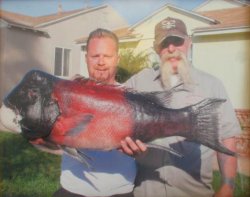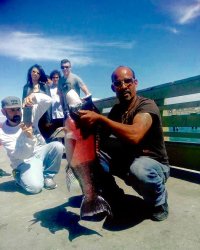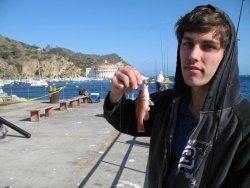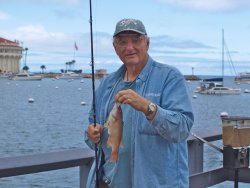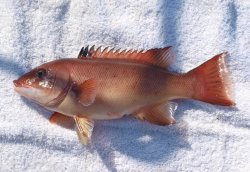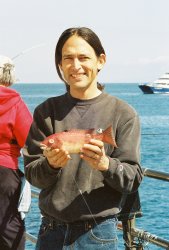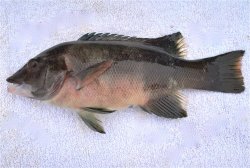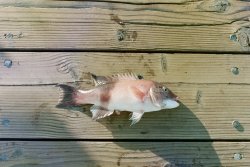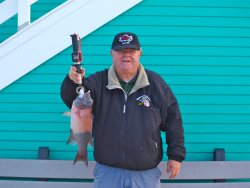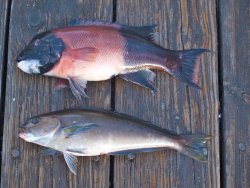Wrasses — Family Labridae
California Sheephead
California Sheephead
Species: Bodianus pulcher (Ayres, 1854); from the Latin pulcher (for beautiful). Sheephead were formerly known by the scientific name (1) Pimelometopon pulchrum; pimelometopon meaning fat forehead and (2) Semicossphus pulcher. Why the new name? Not sure.
Alternate Names: Sheepie, goat, billygoats (large fish), red fish, snaggle tooth, humpy, and fathead. Apparently called West Hollywood fish by some anglers (not sure why). Early day names included California redfish. In Mexico called vieja californiana.
Given the plethora of nicknames for the fish, and the vivid colors—black, red and white, perhaps sheephead could become a mascot for a school. There has been an attempt by some people to replace the mascot at my old school, San Diego State. They want something a little more politically correct than Aztecs or Montezuma. Since the school’s colors are black, red and white, I nominate a fighting fish—sheephead—as the new name for a mascot. But what sounds better, the San Diego State “Sheepheads,” “Sheepies,” “Billygoats,” “Snaggletooths.” or “Humpies?” After all, any of these would be a better name than that used at U.C. Santa Cruz, the “Banana slugs,“ the puny-sounding “Poets” of Whittier College, or even the “Fighting Pickles” of North Carolina School of the Arts. Perhaps we could take a poll and forward it on to the chancellor. Of course a student dressed as a fish might not be nearly as impressive as the current mascot—Aztec warrior “Monty Montezuma.”
Identification: Easily identified by color. Adult females uniform brownish-red to rose; male with black head, red band in middle, and black in posterior portion of body; chin white on both sexes. Males have a large, fleshy lump on their forehead, which increases in size with age. Stout, protruding canine-like teeth in front of mouth; somewhat bucktoothed.
Size: Length to 3 feet, and a weight of 40 lb. 7 oz. (the California diving record fish taken at San Miguel Island in 1992). The California rod and reel record fish weighed 30 lb. 8 oz., and was taken off Newport Beach in 2009. The IGFA World Record fish was a 34 Lb. 8 oz caught at the La Jenelle artificial reel three miles off Ventura in 2018.
The majority of fish taken from piers are much smaller, typically 9-14 inches in length. The largest sheephead I’ve seen reported from piers were a 30+ pound sheephead taken from the San Clemente Pier in July 2010, a 29.7-pound billygoat taken from the Redondo Sportfishing Pier in February 2008, a 27-pound sheepie taken from the Oceanside Pier in April 1998, a 25-pound humpie taken from the San Clemente Pier in June of 21015, a 22.5-pound snaggletooth taken at the Ocean Beach Pier in 2017, and a 22-pound fathead taken from the Shelter Island Pier in 2016.
Marine biologists report a 29-pound sheepie was 32-inches long and 53 years old.
A 22.5 pound sheephead taken by Jose at the Ocean Beach Pier in 2017
Range: Gulf of California and Isla Guadalupe, Pacific Coast, from Cabo San Lucas, southern Baja California, north to Monterey Bay, central California. Common from the Gulf of California and southern Baja California, north to southern California. Although uncommon north of Point Conception, an isolated population is found near the warm water discharge at the Diablo Canyon Nuclear Power Plant near Avila Beach and Port San Luis.
Habitat: Generally found intertidally down to about 180 feet deep, along rocky bottoms and in kelp beds. Recorded to a depth of 492 feet.
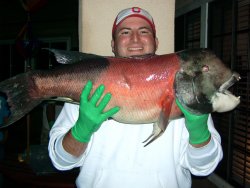
A 22 pound sheephead caught at the Shelter island Pier in 2007
Piers: By far the three best piers are those located on Catalina Island. Two are at Avalon—the Green Pleasure Pier and the Cabrillo Mole, and one is at Two Harbors, the Isthmus Pier. Sheephead are a common daily catch at all three piers. Most coastal piers in SoCal see a few sheephead each year but they are always an unexpected treat. Best bets: Shelter Island Pier, Ocean Beach Pier, Oceanside Pier, San Clemente Pier, Redondo Sportfishing Pier, Santa Monica Pier, Paradise Cove Pier and Goleta Pier (pipe reef).
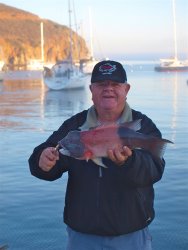
A sheephead caught by myself at the Isthmus Pier at Two Harbors on Catalina Island
Shoreline: A favored fish for rock and jetty anglers in southern California.
Boats: One of the favored boat species for bottom fishermen in southern California. Found in most kelp beds south of Point Conception as well as the offshore islands.
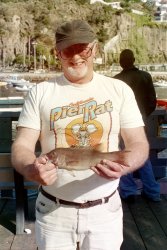
A sheephead caught at the Green Pleasure Pier in Avalon by Boyd Grant (Pierhead)
Bait and Tackle: Medium sized tackle, hooks size 4-2/0, and a variety of baits—shrimp, ghost shrimp, bloodworms, fresh mussels, cut squid—will attract sheephead if they're around the pier.
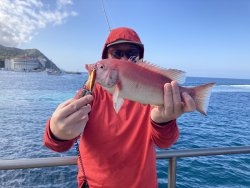
A sheephead taken from the Cabrillo Mole by fish-ninja using an artifical lure
Food Value: Legal-size fish have good-sized fillets that are white in color, mild-flavored and soft textured; the texture becomes increasingly coarse and watery with age. Can be cooked whole, fried, or steamed. Sometimes boiled and flaked for use as a lobster substitute in salads and other recipes. Head sometimes used as stock for fish chowder.
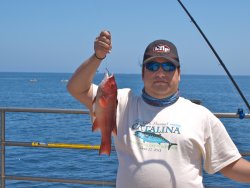
A sheephead taken at the Cabrillo Mole by Redkorn in 2013
Comments: Feeds on such delicacies as sea urchins, sand dollars, sea cucumbers, snails, squid, lobsters, shrimp and crabs. It uses its canine-like teeth to pry food from rocks, which it then crushes with tooth-plates in the rear of the mouth. Can live to over 50 years and is a protogynous hermaphrodite starting life as a female and then turning into a male when about one foot in length and 4 to 5 years in age (although some appear to stay females up to fifteen years of age and some even refuse to change). Why, dear reader, do most of these fish start life as females and then turn into males? The process, by the way, seems to take less than a year. Apparently it is much more effective than that practiced by the medical establishment in California and is, I am sure, much less expensive.
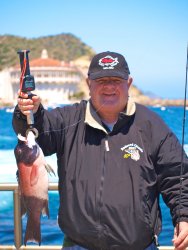
A sheephead caught by myself at the Cabrillo Mole in 2012
Like their family Labridae cousins, rock wrasse and Señorita, sheephead are diurnal fish meaning they sleep at night.
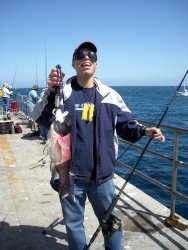
A sheephead caught at the Mole by Robert (Redfish) in 2009
Due to decreasing numbers the daily limit is now only two fish with a minimum size of 12 inches.
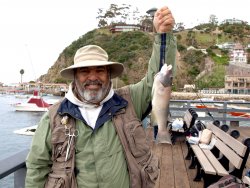
A sheephead caught by Hashem at the Green Pleasure Pier in 2010

